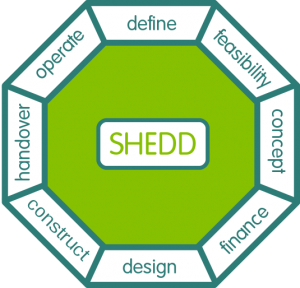
This is our structured process is based on the RIBA plan of work modified for the specific requirements of development of decentralised energy systems. Within SHEDD the gateways between each stage are well defined to ensure that all the required elements are completed before moving onto the next stage. This approach reduces risk and minimises costs.

At the first stage of defining the project, an assessment will be made of the site power, heat and transport demands and how these are planned to evolve with time. With the UK commitment to net zero by 2050, consideration is then given to the desired carbon trajectory for the site/project, a reference carbon trajectory for the project is defined.
The feasibility stage SHEDD uses early stage system modelling techniques to provide site/ project specific technical and commercial feasibility of a range of candidate technologies. Pathways to “netzero3” are then developed and tested under a wide range of assumptions to provide a reference concept energy system design that is capable of delivering the reference trajectory.
The projected carbon trajectory of the proposed pathway can be tested against the desired carbon trajectory. Key staging points are identified and the overall system concept defined. This approach helps ensure that the infra-structure is future proof and greatly reduces the risk of ending up with any stranded energy assets. The approach also allows the maximum use of any existing assets and recognises the value of utilising bridging or enabling technologies on the pathway to net-zero.
The concept design specification provides for a phased approach that will take into account both the planned build -out phases of the development, the interaction of projected heat, power and transport demands on the way to deep decarbonisation of heat power and transport.

